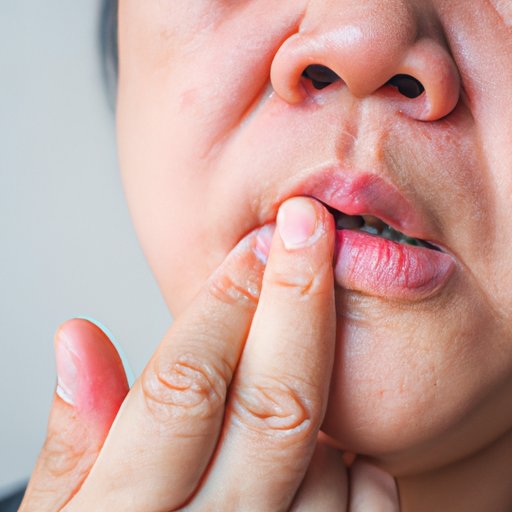Introduction
Hand, Foot and Mouth Disease (HFMD) is a common childhood illness that can affect people of all ages. It is caused by a virus, typically one of the coxsackieviruses, and spreads easily from person to person through contact with saliva, mucus, or feces. Symptoms of HFMD include fever, sore throat, mouth sores, and a rash on the hands and feet. While it is usually mild and resolves in 7-10 days without medical intervention, it can lead to more serious complications in some cases.
This article will provide an overview of Hand, Foot and Mouth Disease, including how long it lasts, when you are contagious, symptoms and treatment, understanding the causes, preventing the spread, communicating with your child, and answering common questions.
How Long Does Hand, Foot and Mouth Disease Last and When Are You Contagious?
Hand, Foot and Mouth Disease typically lasts for 7-10 days, although the symptoms may take several weeks to completely resolve. The virus is most contagious during the first week of infection, but can still be spread for several weeks after the initial onset of symptoms.
It is important to note that you can be contagious before any symptoms appear. Many individuals who contract HFMD may not experience any symptoms at all, but can still pass the virus to others. Therefore, it is important to practice preventive measures even if you don’t have any visible signs of the disease.
Symptoms & Treatment of Hand, Foot and Mouth Disease and When Are You Contagious?
The most common symptoms of Hand, Foot and Mouth Disease include fever, sore throat, mouth sores, and a rash on the palms of the hands and soles of the feet. In some cases, the rash may also appear on the buttocks, arms, or legs. Other symptoms may include loss of appetite, fatigue, nausea, and irritability.
Most cases of Hand, Foot and Mouth Disease require no medical treatment and will resolve within 7-10 days. To help relieve discomfort, it is important to ensure that children stay hydrated and avoid acidic foods and drinks. Over-the-counter pain medications such as ibuprofen or acetaminophen can also be used to reduce fever and pain.
What Is Hand, Foot and Mouth Disease and When Are You Contagious?
Hand, Foot and Mouth Disease is caused by a virus, typically one of the coxsackieviruses. The virus is highly contagious and can spread through contact with saliva, mucus, or feces. It can also be spread through contact with contaminated objects such as toys, doorknobs, or other surfaces. It is important to note that you can be contagious before any symptoms appear.
It is possible to contract Hand, Foot and Mouth Disease more than once, as the virus can mutate. However, this is rare and most individuals only contract it once in their lifetime.
Preventing the Spread of Hand, Foot and Mouth Disease and When Are You Contagious?
The best way to prevent the spread of Hand, Foot and Mouth Disease is to practice good hygiene. This includes washing your hands regularly with soap and water, avoiding contact with those who are infected, and cleaning and disinfecting frequently touched surfaces. It is also important to avoid sharing items such as towels, utensils, and toys with those who are infected.
If your child has Hand, Foot and Mouth Disease, it is important to keep them home from school or daycare until they are no longer contagious. This typically takes 7-10 days after the initial onset of symptoms.
Explaining Hand, Foot and Mouth Disease to Your Child and When Are You Contagious?
Explaining Hand, Foot and Mouth Disease to your child can be a difficult conversation. It is important to be honest and open with your child about the illness and what they can do to prevent the spread. Emphasize the importance of good hygiene practices such as washing their hands regularly and avoiding contact with those who are infected.
It is also important to explain why it is necessary for them to stay home from school or daycare until they are no longer contagious. This will help them understand the importance of following the guidelines and practicing good hygiene.
Common Questions About Hand, Foot and Mouth Disease and When Are You Contagious?
One of the most common questions about Hand, Foot and Mouth Disease is whether there is a vaccine available. Unfortunately, there is currently no vaccine available for this virus. The best way to prevent the spread of the virus is to practice good hygiene and avoid contact with those who are infected.
Another common question is whether the virus can be transmitted through the air. While the virus can be spread through contact with saliva, mucus, or feces, it cannot be spread through the air.
Conclusion
Hand, Foot and Mouth Disease is a common childhood illness that can affect people of all ages. It is caused by a virus and spreads easily from person to person through contact with saliva, mucus, or feces. Symptoms of HFMD include fever, sore throat, mouth sores, and a rash on the hands and feet. Most cases of Hand, Foot and Mouth Disease require no medical treatment and will resolve within 7-10 days.
The best way to prevent the spread of Hand, Foot and Mouth Disease is to practice good hygiene. This includes washing your hands regularly with soap and water, avoiding contact with those who are infected, and cleaning and disinfecting frequently touched surfaces. It is also important to explain the illness to your child in an age-appropriate manner to ensure they understand the importance of following the guidelines and practicing good hygiene.
For more information about Hand, Foot and Mouth Disease, please visit the Centers for Disease Control and Prevention’s website: https://www.cdc.gov/hand-foot-mouth/index.html
(Note: Is this article not meeting your expectations? Do you have knowledge or insights to share? Unlock new opportunities and expand your reach by joining our authors team. Click Registration to join us and share your expertise with our readers.)
